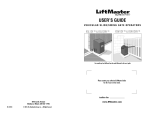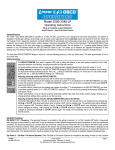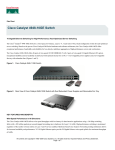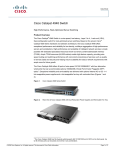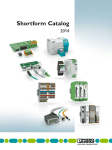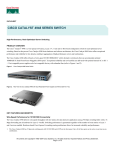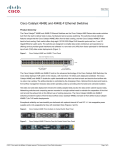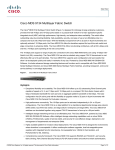Download LMA-1800 - Eberle Design Inc.
Transcript
INDUCTIVE LOOP VEHICLE DETECTOR SINGLE CHANNEL DUAL PROGRAMMABLE SOLID STATE OUTPUTS PLUG-IN COMPATIBLE WITH: o Chamberlain/Elite SL3000, CSW200 o Advanced Access Automation CSL2000, CSW2000, RSW1000 o All-O-Matic SL100-DC, SL 150DC, OH 200DC, SW 300DC, SW350DC o Intelligate Systems IQ500, IQ5000 o Linear (OSCO) SL & SW Series with APeX controller o SECOM Late model operators with 10-pin Molex connectors o Viking Access Models L-3, F-1, T-21, H-10, B-12, Q-4 o Apollo 4300, 4500 Eberle Design, Inc. (EDI) provides access professionals with reliable, high quality mission critical vehicle detection products that will improve the performance and lifecycle of your access control systems. EDI’s wide range of vehicle detection products help technicians save valuable time and maximize profits by quickly installing, accurately trouble-shooting, and reliably maintaining access control systems with easy to use hi-tech vehicle detectors that provide built-in set-up tools, frequency & sensitivity meters, and non-volatile diagnostic history, all of which are valuable and always available – Because they’re built-in! ENHANCED FEATURES DEFLECTOMETER®: Sensitivity Meter: Frequency Meter: Ten (10) Levels of Sensitivity: One Model Covers ALL Low Voltages: Advanced Loop Diagnostics: Loop Fault Memory: Call Output Memory: 2 Second Delayed Detection: The front panel 7-segment LED DEFLECTOMETER® provides visual feedback and assistance for setting the correct sensitivity, reading the frequency of the loop, reporting Loop Faults, and indicating Delay & Extension Timing functions. With a typical size vehicle over the roadway loop, the DEFLECTOMETER® functions as a Sensitivity Meter. The optimum sensitivity setting should provide a reading of “5”. You can adjust the DEFLECTOMETER® reading by using the front panel UP or DOWN sensitivity buttons. Automatic quantitative feedback of the loop system operation ensures that the detector is set to the most optimum sensitivity level to detect ALL vehicles, including motorcycles and high-bed vehicles. Following power-up or reset, the DEFLECTOMETER® will indicate a 2 or 3 digit number (quickly flashes) that indicates the loop frequency of the loop & loop network. Keeping your loops separated by at least 5 KHz avoids crosstalk problems and future service calls. 10 levels of sensitivity (0 to 9) can be easily set using the UP or DOWN push buttons. LMA-1800 operates on 12VDC, 24VDC, and 24VAC The Loop Fault Monitor continually checks the integrity of the loops and will report and store 3 types of loop faults; Open Loops, Shorted Loops, and 25% sudden changes in inductance. The Loop Fault Memory uses internal Non-Volatile memory to store and display the current and previous loop faults utilizing the front panel “Loop Fault” LED and DEFLECTOMETER®. A power loss or reset will not delete this memory. A MUST FOR TROUBLESHOOTING! The detector will not drop a Call state if power is lost for a minimum of 4 seconds or less. A 2-second CALL delay time can be provided via the program DIP switch. STANDARD FEATURES Automatic Tuning - Lightning & Surge Protection - Four (4) Frequency Levels - Compatible with ALL radio controls & remote openers - Sensitivity Boost - Fail Safe and Fail Secure Configurations - Separate Color-Coded LED indicators - Wide Loop Inductance Range: 20 to 2500 micro Henries – Velcro pull tab for easy extraction from the rack LMA-1800 Catalog Sheet – 063014 Designed, Manufactured and Tested in the United States of America Deflectometer is a trademark of EDI LMA-1800 DEFLECTOMETER ® INDUCTIVE LOOP VEHICLE DETECTOR Single Channel with Dual Programmable Solid State Outputs SPECIFICATION Controls: PCB mounted DIP switch (8 position) and front panel push buttons allow the user to set up operational parameters including frequency & sensitivity. All switch settings, excluding the frequency switch settings, dynamically update immediately when changed. The front panel “RESET” push button is provided for resetting the detector and for reviewing previous loop fault conditions stored in the internal memory. Reset (Power up): The detector can be manually reset by pressing the front panel RESET button or interrupting power. Upon power up, the loop frequency is displayed (quickly flashes) on the 7segment LED. (i.e. apply power and two or three numbers will display (quickly flashes) within two seconds. As an example, you may see a “2” then a “5”, indicating 25 kilohertz. This feature is a great tool for separating frequencies of adjacent loops to avoide crosstalk. Typically you DO NOT want to two detectors/loops to be within 5 kilohertz of each other. Setting Sensitivity - Front Panel Sensitivity Push Buttons The DEFLECTOMETER® (front panel 7-segment LED) aids in setting the DETECTOR quickly and easily to the most optimum sensitivity level to ensure the trouble-free detection of all vehicles, including motorcycles and high bed vehicles. For typical vehicles (mid-size vehicle / small pick up) utilizing properly installed roadway loops, a value of 5 displayed on the DEFLECTOMETER® during the DETECT output period indicates an optimum sensitivity setting. For high profile vehicles (commercial trucks, 4x4’s, etc…), a DEFLECTOMETER® reading of 4 will be optimum. For low profile vehicles (sports cars, etc…), a DEFLECTOMETER® reading of 6 will be optimum. Adjusting sensitivity using the DEFLECTOMETER® (recommended): The DEFLECTOMETER® should read zero (0) with no vehicle over the roadway loop. When the typical vehicle is completely in the detection zone (OUTPUT indicator On), the sensitivity should be adjusted up or down until the DEFLECTOMETER® displays the desired optimum value of 5 (or 4 or 6 as described above). If a typical vehicle located over the roadway loop causes the number “7” to be displayed on the DEFLECTOMETER®, the sensitivity should be decreased two levels. This can be done by pressing the front panel SENS button two times. If a typical vehicle located over the roadway loop causes the number “2” to be displayed on the DEFLECTOMETER®, the sensitivity should be increased three levels. This can be done by pressing the front panel SENS button three times. NOTE: THE DEFLECTOMETER® DYNAMICALLY UPDATES AFTER EACH SENSITIVITY LEVEL CHANGE, ALLOWING YOU TO CHANGE SENSITIVITY SETTINGS WHILE A VEHICLE REMAINS IN THE LOOP DETECTION ZONE. Adjusting sensitivity without using the DEFLECTOMETER® (manually setting sensitivity): The DETECTOR offers 10 levels of sensitivity (0 to 9). Level 9 is the highest sensitivity. Sensitivity can be manually set to any desired level by pressing the front panel SENS buttons ( or) when a vehicle is NOT over the roadway loop. The first time a SENS button ( or) is pressed, the current sensitivity level is displayed on the DEFLECTOMETER® for 5 seconds. If either SENS button ( or) is pressed again before the 5 second period ends, the sensitivity setting will increase (SENS ) or decrease (SENS ). The new sensitivity value will be displayed on the DEFLECTOMETER® display for 5 seconds. The factory default Sensitivity setting is level 4. Loop Frequency (2 Position DIP Switch - DIP 1 & 2): Four frequencies, normally in the range of 13 to 150 kilohertz are DIP switch selectable. To help eliminate crosstalk problems, the loop frequency is displayed on the front panel DEFLECTOMETER. Following power-up or Reset, the display will indicate a two or three digit number (quickly flashing mode) that indicates the loop frequency. As an example, you may see a "2" followed by a "5", indicating 25 kilohertz. This feature is a great tool for separating frequencies of adjacent loops to avoid crosstalk. Typically you want two detectors (loops) to be separated by at least 5 kilohertz. Fail Safe / Fail Secure Operation (8 Position DIP Switch - DIP 3): When operating in the Fail Safe mode Output A will assume the “DETECT” output state during a loop fault condition. When in the Fail Secure mode Output A will not respond to loop failures. Output Relay “B” Modes (8 Position DIP Switch - DIP 4 & 5): Four modes of operation are selectable from DIP switches 4 & 5; Presence, Pulse on Entry, Pulse on Exit, or Fault. Switch 4 Switch 5 Function OFF OFF Output is ON during loop fault condition. OFF ON 250 millisecond pulse on vehicle exit. ON OFF Duplicates operation of Output “A”. ON ON 250 millisecond pulse on vehicle entry. 2-Second Output Delay (8 Position DIP Switch - DIP 6): This feature may be turned ON, via the 8 position DIP Switch, so outputs A & B will be delayed for a period of 2 seconds after a vehicle has entered the detection zone. Note, the DEFLECTOMETER will display the letter “d” during the delay period. If the vehicle does not remain in the loop zone for the full 2 seconds the delay will terminate and no DETECT output will be produced. Output Relay “A” Modes (8 Position DIP Switch - DIP 7): Two modes of Presence operation are selectable; Infinite Presence or Normal Presence. When OFF (Infinite Presence Mode), a presence OUTPUT will always be maintained as long as a vehicle is present and power is not removed for more than approximately 3 seconds. When ON (Normal Presence Mode), the output hold time is between 5 minutes minimum and 3 hours maximum. Hold time depends on loop geometry, number of wire turns in the loop, vehicle size, and position of the vehicle relative to the loop. Sensitivity Boost (8 Position DIP Switch - DIP 8): This feature may be turned ON from the 8 Position DIP Switch to increase sensitivity only during the DETECT output period. When a vehicle enters the loop, the detector sensitivity is boosted to a higher level than the vacant loop setting. The boosted sensitivity remains throughout the DETECT period. When the vehicle leaves the loop, the sensitivity returns to the vacant loop setting. This feature helps prevent dropouts during the passage of high bed vehicles and is particularly useful in sliding gate situations. Power / Loop Fault Status Indicator (Green LED): Indicates power status during normal detector operation. In addition to indicating power status, while a “Real-Time” fault is being detected, the RED OUTPUT LED and the GREEN POWER LED continuously emit a sequence of flashes together. When only the GREEN LED continuously emits a sequence of flashes, a fault had occurred and the detector had self corrected. Each type of fault is identified by a different flash sequence. See “Loop Fault Monitoring” and “Loop Fault Memory”. Note: The POWER LED also flashes every 2 seconds during “Brown out” conditions, indicating insufficient line power. Output “A” Status Indicator (Red LED): Vehicle Detection = Steady ON Loop Fault Conditions (See Loop Fault Monitoring) 2-Second Delay = Flashes at a 2 Hz rate Output “B” Status Indicator: There is no status indicator for Output “B”. Loop Fault Monitoring: The detector continuously checks the integrity of the loop. The system is able to detect shorted or open circuit loops, or sudden changes in inductance exceeding 25% of the nominal inductance. If a fault is detected, the DETECT and POWER LEDs continuously emit a sequence of flashes. Additionally, the 7-Segment DEFLECTOMETER displays the code “F1”, “F2”, or “F3” indicating a current loop fault. Each type of fault is identified by a different flash sequence: Flash Sequence Fault Display 1 flash Open Circuit Loop F1 2 flashes Shorted Circuit Loop F2 3 flashes 25% excessive change in inductance F3 If the Open or Shorted fault condition self heals, the Output LED’s and 7-Segment DEFLECTOMETER will return to normal operation. The POWER LED will continue to flash with the sequence signifying the type of fault that was last detected. In the case of the excessive inductance change fault, the unit will retune to the new inductance after a period of two seconds and continue operation. The fault condition will be indicated by the flash sequence of the POWER LED. Pressing the “Reset” button will reset the detector and clear the flash sequence from the POWER LED (Note: After pressing reset, the frequency will be displayed on the DEFLECTOMETER). Should you want to review the last loop fault condition, simply press and hold the “Reset” button for 2 seconds. See “Loop Fault Memory”. Loop Fault Memory: Previous loop faults are stored in non-volatile (internal) memory. If power is interrupted, for any length of time, the detector will not loose the last loop condition status, which is valuable information for troubleshooting purposes. When power is restored to the detector, the GREEN POWER / FAULT LED will automatically indicate the last loop status condition (open loop, shorted loop, 25% excessive change in inductance or no loop problem occurred). Momentarily pressing the front panel Reset button will reset the loop fault memory and the detector. However, should you want to review the last loop condition, simply press and hold the reset button for 2 seconds. See “Loop Fault Monitoring”. CALL Output Memory: A power loss of 3 seconds or less will not drop the CALL (DETECT) Output. Basically when power is removed for 3 seconds or less, then restored, the detector will automatically remember if a vehicle is present over the roadway loop. Self Tuning: The Detector will automatically tune to any loop and lead-in combination within the tuning range upon application of power. Environmental Tracking: The Detector automatically and continuously compensates for component drift and environmental effects throughout the tuning range and across the entire temperature range. Loop Inductance (Tuning) Range: 20 to 2500 micro-Henry with a Q factor greater than 5. Loop Input (Lightning Protection):The loop input incorporates lightning and transient protection devices and the loop oscillator circuitry is transformer-isolated. The lightning protection will withstand the discharge of a 10 uF capacitor charged to 2,000V across the loop inputs or between either loop input and earth ground. The transformer isolation allows operation with a loop which is grounded at a single point. Grounded Loop Operation: The Detector will operate when connected to poor quality loops including those that have a short to ground at a single point. Internal Circuitry Isolation: All internal electronic circuitry is isolated from the loop by means of the loop isolation transformer. Lead-in Length: The Detector will operate with lead-in (feeder) lengths up to 5,000 feet with appropriate loops and proper lead-in cable. Output Rating(s): Open Collector Transistor referenced to DC Common. Max current rating 100 mAmps. Max voltage 30 VDC. Construction: Printed circuit boards are double sided 1oz. copper with plated through holes. Circuit boards are conformally coated for environmental protection. Environmental: Operating Temperature Range: -34oC to +74oC (-30oF to 165oF) Humidity Range: 0 to 95% relative. Mechanical: Dimensions: 2.30” (5.84 cm.) high x 2.75” (6.98 cm.) wide x 0.80” (2.03 cm.) thick Weight: 1.50 oz. (42 g.) Power Supply: 10 to 30 VDC or 14 to 26 VAC, 50 mA max. Connector: Rear mount 10 pin male female Molex type 09-48-1104. Mates with other male PCB 0.156” pitch headers used by many gate, parking and access control devices. Pin Assignment (Connections): Pin Function 1 Loop Input 2 Loop Input 3 Power (+10 to 30 VDC or 26 VAC) 4 No Connection 5 No Connection 6 Output B 7 Output B Inverted 8 Output A (Presence Output) 9 Power (+10 to 30 VDC or 26 VAC) 10 DC Common NOTE: Power applied on either pin 3 or 9, or both. Default Settings: Sensitivity ......................................................................................................................... Level 4 Output “A” ........................................................................................................ Infinite Presence Output “B” .................................................................................................................. Fail Output Sensitivity Boost .................................................................................................................. OFF 2-Second DETECT Delay ................................................................................................... OFF Configuration ................................................................................................................ Fail Safe


